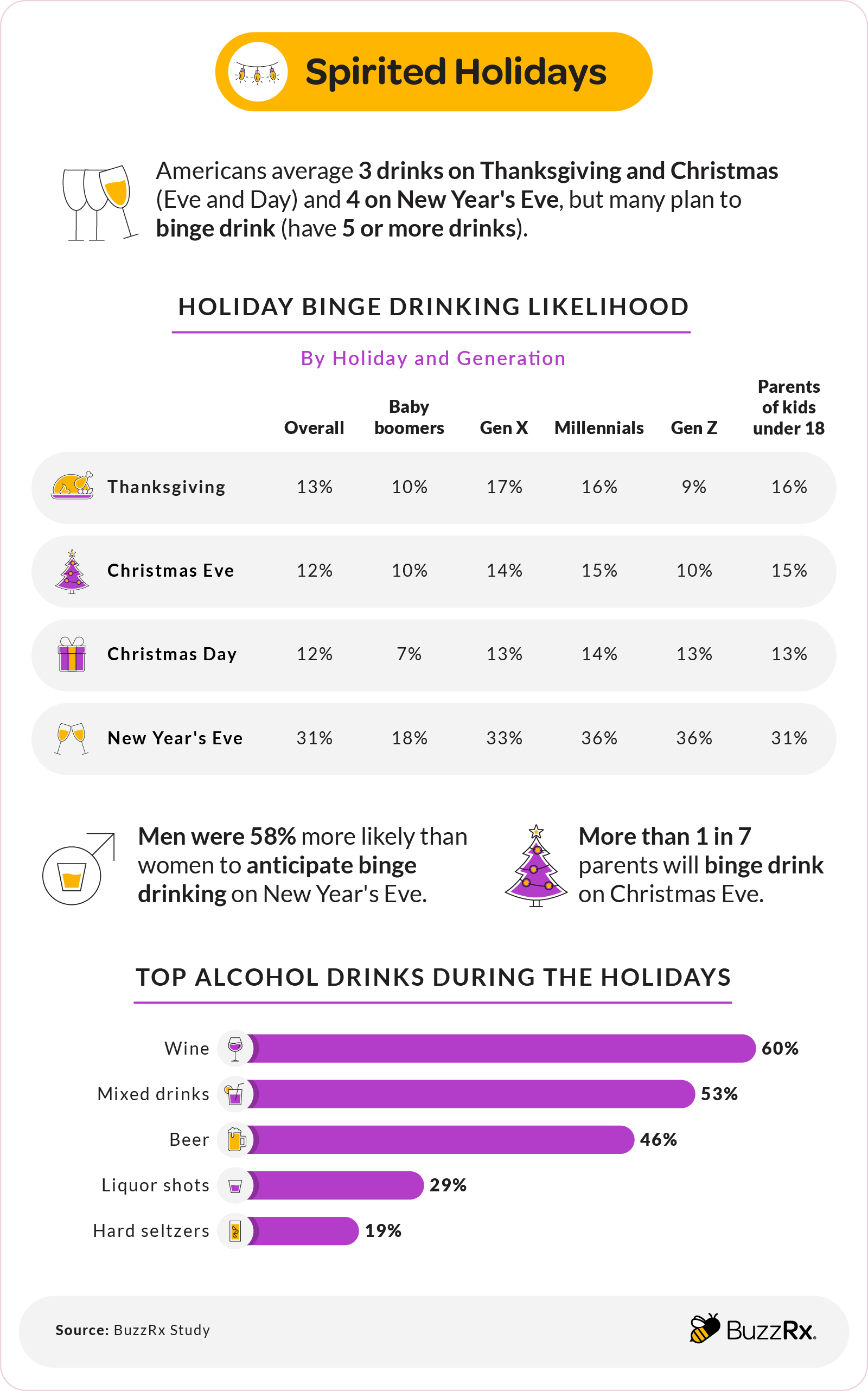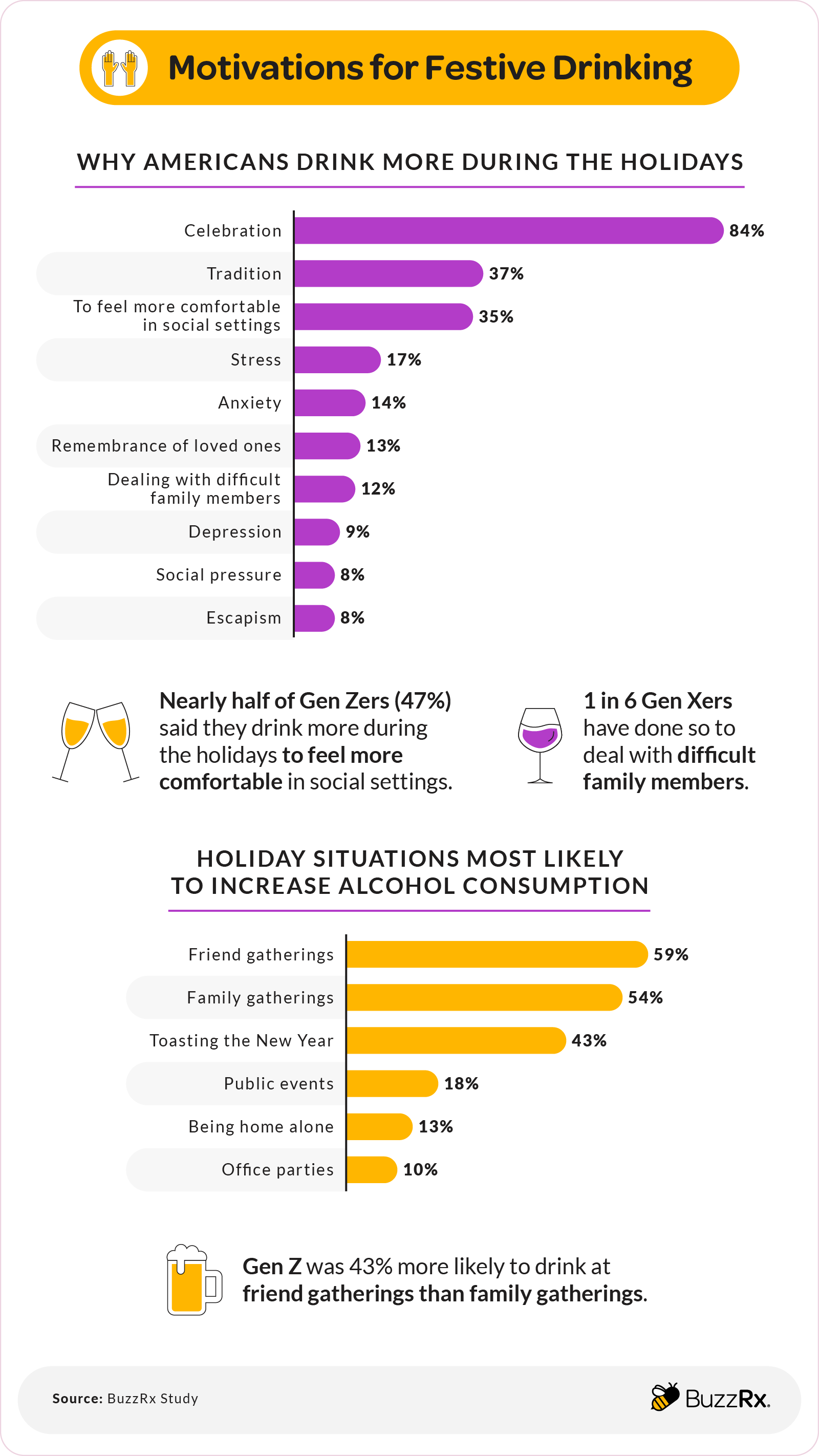Holidays on the Rocks


As we enter the holiday season, it’s not just the festive decorations and family gatherings that take center stage but also the complexities of alcohol consumption and medication use. Our survey of 1,003 Americans across generations uncovers the patterns of binge drinking, medication mixing, and the possible interest in alternatives to alcohol during these celebratory times.
Key Takeaways
-
Over 3 in 10 Americans said they expect to binge drink this New Year’s Eve.
-
More than 1 in 7 parents of minors said they will binge drink on Christmas Eve.
-
Nearly half of Gen Zers (47%) shared that they drink more during the holidays to feel more comfortable in social settings.
-
Despite 93% of Americans being aware of potential effects, nearly 3 in 10 have mixed medication with alcohol.
-
More than 1 in 10 respondents expressed interest in a pill that diminishes the desire to drink — most were Gen Zers.
The spirit of the season
Our look into holiday drinking habits showed stark differences in motivations and settings across generations.

A shadow lurks behind this season’s festive cheer: binge drinking. Our research classifies this as consuming five or more drinks on a single occasion. That definition applies to men; for women, it’s reduced to four drinks.
New Year’s Eve stood out as the holiday most associated with such indulgence. On this night, more than 3 in 10 are likely to binge drink, most likely using beer (60%), mixed drinks (58%), or wine (49%). More than 1 in 7 parents of minors plan to partake in binge drinking on Christmas Eve — slightly more of them than on Christmas Day (13%). The night before Christmas might mark the end of a lot of hard work for parents, but there are alcohol-free ways to unwind, too.
As for the reasons behind increased alcohol consumption during the holidays, we found some intriguing generational differences and motivations.

Nearly half of Gen Zers (47%) admitted to drinking more during this season to ease social discomfort. This reflects a concerning trend among America’s youngest legal drinkers, especially since Gen Zers were 15% more inclined to use alcohol as a social lubricant during festive gatherings than millennials.
The holiday settings where different generations have chosen to imbibe also varied. Gen Z participants were 43% more likely to drink at gatherings with friends than at family events. This preference starkly contrasts with baby boomers, who were 19% more likely to drink at family gatherings. Meanwhile, Gen X was most likely to drink alone at home during the holidays (16%).
Festively Cautious: Medication and Alcohol
Amidst the joy of celebrating with loved ones, managing medications responsibly becomes a critical yet often overlooked aspect of holiday festivities.

Combining alcohol and medication presents a complex and concerning scenario during the alcohol-heavy holiday season. Despite 93% of Americans acknowledging the potential effects, our study revealed that nearly 3 in 10 have mixed medications with alcohol. This gap between knowledge and behavior could point to a serious public health concern.
Generational distinctions emerged again, perhaps putting some at higher risk than others. Gen Z respondents showed a 31% greater likelihood of combining alcohol with prescription drugs compared to over-the-counter (OTC) medications, including commonly used examples like acetaminophen. This contrasted sharply with baby boomers, who were 15% more inclined to mix alcohol with OTC drugs than with prescriptions.
There was also a notable gender difference in medication management around the holidays: Women were 22% more likely than men to hide their medications during family gatherings or holiday events. This may reflect a greater concern among women about medical privacy or social judgment — the top two reasons Americans shared for hiding their medication in these situations.
Curbing Holiday Drinking
Would Americans take a pill to help them drink less? Based on our findings, the concept of medication that diminishes the desire to drink could garner interest from those looking to moderate their alcohol intake.

Alcohol often plays a central role in holiday celebrations, and a medication that curbs the desire to drink is attracting attention. Naltrexone manages alcohol cravings by reducing the desire to drink. Our survey found that more than 1 in 10 respondents were intrigued by the prospect of such a pill to help moderate their drinking during holiday festivities.
The appeal of these medications varied markedly by generation. Gen Z individuals showed the highest level of interest (13%) in a pill that reduces the urge to drink during holiday celebrations, reflecting this younger generation’s awareness of the risks associated with alcohol. In contrast, only 7% of baby boomers expressed interest.
However, nearly half of the Gen Z respondents (46%) expressed concerns about the long-term health implications of taking such medication. In addition, almost 1 in 5 baby boomers worried about the drug’s potential interactions with their other medications. Medication cost was another major concern for 2 in 5 respondents.
Safer Holiday Celebrations
Our survey’s insights into the interplay between holiday celebrations, binge drinking, and mixing alcohol with medication underlines the need for bridging the gap between awareness and practice. Investigating the potential of medications like Naltrexone to curb alcohol cravings also presents an opportunity for more responsible holiday indulgence. Emphasizing mindfulness and health-conscious choices during festive times is essential for safer and more enjoyable celebrations.
Methodology
We surveyed 1,003 Americans to explore alcohol consumption habits during the holidays. Generationally, this sample size included 25% baby boomers, 26% Gen X, 26% millennials, and 24% Gen Z (totaling over 100% due to rounding).
About BuzzRx
BuzzRx is committed to improving public health by making prescription medications more affordable and accessible for everyone. With a free prescription discount card, users can save significantly at over 60,000 pharmacies nationwide.
Fair Use Statement
You may share this article’s findings for non-commercial purposes, but please include a link back to this page for proper attribution.
SOCIAL